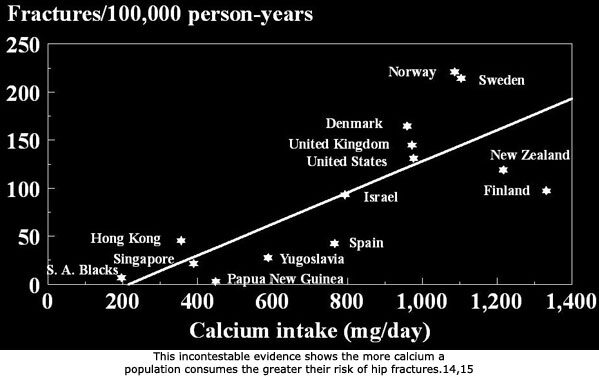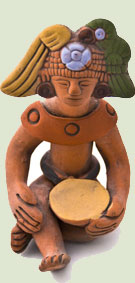When Friends Ask: Where Do You Get Your Calcium?

By John McDougall, MD
One of the first questions concerned family and friends ask when they learn you have become vegan and now avoid all animal products, including dairy products is, “Where do you get your calcium?” Begin your dialog with them by assuming that the questioners have sincere interests in expanding their knowledge about good nutrition—rather than just them trying to prove your diet is deficient, and to justify their daily eating of Ben and Jerry’s Homemade Chocolate Chip Cookie Dough Ice Cream and French brie ripened to perfection with a bottle of deliciously dry white wine.
Misinformation Is Promoted for Profits
We have all grown up educated about proper nutrition by the food industries, and the leader in “diet schooling” is the dairy industry. You might remember, at the center of these instructional campaigns has been “a teaching cow:” In my youth, living in the Midwest, I learned about the importance of “milk for building strong bones” from Elsie, the cow. Lani Moo took over my education on “never out growing my need for milk” when I moved to Hawaii as a young doctor in the early 70s. In the mid 80s we settled in Northern California where Clo, the cow, provided dairy-friendly advice from billboards lining Highway 101. These cows are innocent participants in the enormous marketing efforts to sell products to correct a non-existent problem: dietary calcium deficiency.
One nutrient stands out as especially abundant in dairy foods: calcium. You might expect marketers to exploit this feature to sell cow’s milk to customers. To do this they had to create the fear that without their products, uniquely concentrated in calcium, people will develop disease—in this case fragile bones. Total U.S. farm income from dairy products in 2020 was $42.5 billion US dollars and much of this is spent to spread the myth that dairy foods are not only a healthy choice, but are also essential to avoid becoming sick.1 They write, “To meet calcium recommendations, increased consumption of calcium-rich foods such as milk and other dairy foods, often is necessary. Unfortunately, few Americans consume sufficient calcium, thereby increasing their risk for major chronic diseases such as osteoporosis.”2 And their fear mongering is working: Today, the average person consumes more than 593 pounds of dairy products annually, compared to 522 pounds in 1983.3
Calcium Is a Mineral Found in the Ground
Ask first, where does calcium come from? I mean originally? The source of all calcium is the soils of the earth. Animals do not eat ground—so how do they obtain this essential mineral? Plants absorb this basic element, present in watery solutions, through their roots, and then incorporate it into their various tissues—roots, stems, leaves, flowers, and fruits. Animals then eat the plant parts to obtain calcium and all other essential minerals. Acting as the sole conduit, plants are loaded with minerals, in amounts sufficient to grow the skeletons of the largest animals that walk the earth, like the elephant, hippopotamus, giraffe, horse, and cow. Since these massive bones can be formed from the raw materials of plants, you can assume there is sufficient calcium in vegetable foods to grow the relatively small bones of a human being. Current observations and human history prove this: Most people who have ever walked this earth have grown their normal-sized adult skeletons without the aid of milk (other than mother’s milk during the first two years of life) and without concentrated calcium pill supplements.
Calcium Is a Necessary Nutrient
Calcium is essential for all living organisms—microbes, plants, and animals. The average adult body contains approximately 1 kg (2.2 pounds) of calcium. This represents the most abundant mineral in the human body and bones serve as an important storage depot for this calcium—99% of it is found in the skeleton in the form of calcium phosphate salts. In mammals, calcium plays a crucial role in processes ranging from the formation of the skeleton to the regulation of nervous tissue and blood vessel function. Calcium balance is maintained by the actions of three organ systems—gastrointestinal tract, bone, and kidney.
These three organs are precise and efficient at regulating the amount of calcium in our bodies. If our diet is relatively low in calcium, then the cells of the intestinal tract will act more vigorously and absorb a higher percentage of the calcium from the food. At the same time, the kidneys will act to conserve the body’s calcium. On the other hand, if we follow the messages of the calcium industries and begin consuming glassfuls of milk or handsful of supplements then the intestinal cells will act with their innate intelligence to block out the entrance of most of this concentrated calcium, and the kidneys will simultaneously eliminate any excess. If this were not the case, then the influx of excess calcium would by necessity be deposited in the soft tissues of the body—heart, kidneys, muscles, skin—and we would become sick and could die. Clearly, the body has many integrated mechanisms to assure that the proper balance of essential minerals is maintained—regardless of the choices we may make at the fast food window.
Human Calcium Needs Are Surprisingly Low
A recent study of Inuit (Eskimo) children found their diet, consisting largely of meat (which has almost no calcium), provided about 120 mg of calcium daily, but because of their physiologic adaptations these children were found to be healthy.4 As long ago as 1978 Paterson wrote in the Postgraduate Medical Journal, “Many official bodies give advice on desirable intakes of calcium but no clear evidence of a calcium deficiency disease in otherwise normal people has ever been given. In Western countries the usual calcium intake is of the order of 800-1000 mg/day; in many developing countries figures of 300-500 mg/day are found. There is no evidence that people with such a low intake have any problems with bones or teeth. It seems likely that normal people can adapt to have a normal calcium balance on calcium intakes as low as 150-200 mg/day and that this adaptation is sufficient even in pregnancy and lactation. Inappropriate concern about calcium intake may divert attention and resources from more important nutritional problems.”5 And that is exactly what the talented marketing people in the dairy industry have done with the help of friendly government officials in the USDA: they have placed the spotlight on the nutrient, calcium, which is easily obtained in sufficient amounts from almost any diet—and at the same time, taken the beam of truth off of the fat, cholesterol, and contamination—the life-threatening components of dairy foods. One of the ways this has been done is by sensationalizing rare cases of calcium deficiency in children on bizarre diets.
An Unnaturally Low Calcium Diet Can Cause Rickets
In the past I have said, “Calcium deficiency is unknown in human beings.” In other words, there is no disease that has ever been reported as due to too little calcium in a person’s diet. This statement was based on a comprehensive review of the scientific literature covering the various diets (with and without dairy foods) that people consume worldwide. However, if you look hard enough, exceptions to generalizations, such as the one I (and others) have made about the lack of calcium deficiency in people can be found—and exploited.
Rare cases of a calcium deficiency condition called “nutritional rickets” have been reported. Rickets is a condition of weakening of the bones of children, leading to fractures and deformity. Inadequate vitamin D due to insufficient exposure to sunlight is the recognized cause of almost all cases of rickets. However, at the extremes of low calcium intake, caused by consuming unusual diets, rickets can rarely occur even with adequate sunshine exposure.6
Reported examples of children suffering from “nutritional rickets” fall far outside what would be considered normal diets. For example, one case was described in a 16-month-old girl, who, because of allergy to formula, was raised on a mixture of applesauce and oatmeal—with no milk until after the age of one-year.7 (She, of course, should have been on breast milk her first year of life.) The authors felt the high phytate content of the oatmeal impaired absorption of the calcium in her food, causing her disease. In another report, three children, aged 15-18 months developed rickets due to a diet of a commercial Soya-drink—not adapted for infants—as their main source of nutrition for at least 6 months. The Soya-drink was extremely low in calcium content.8
In rural Africa children ages 4-16 years have been found with active rickets believed to be due to diets high in phytate with calcium intakes estimated to be approximately 200 mg/day (a level significantly lower than other children living in the same community).9 However, a study of one hundred and thirty Ethiopian children under five years old with rickets on a lower calcium diet showed this condition was always due to inadequate sunshine.10
So how have these rare cases of nutritional rickets from consuming bizarre diets changed my claim that, “disease due to calcium deficiency is unknown in humans?” I must now add to the end of the sentence this qualification: “on natural diets.” Whole plant foods easily meet our needs for calcium after infancy. (Human milk is the necessary food during the beginning years.) Therefore, you can be reassured that you and your children cannot possibly fail to consume sufficient calcium for all of your needs from a natural plant-food-based diet, like the starch-based McDougall diet. If you do develop such a problem, then you will make national headlines as the first reported case—and you will become an important part of the dairy industry’s advertising campaign—a shining example of what can happen when you fail to follow their advice.

Dairy Foods Are Found Unnecessary for Children
Contrary to the dairy industries marketing campaign, reviews of the scientific literature have concluded extra dietary calcium during childhood does not build strong bones. A review published in the March 2005 issue of the Journal of Pediatrics focused on the benefits of dairy products on bone health and concluded, “Scant evidence supports nutrition guidelines focused specifically on increasing milk or other dairy product intake for promoting child and adolescent bone mineralization.”11
A recent metaanalysis published in the October 2006 issue of the British Medical Journal found, “The small effect of calcium supplementation on bone mineral density in the upper limb is unlikely to reduce the risk of fracture, either in childhood or later life, to a degree of major public health importance.”12 The authors state, “Our results do not support the premise that any type of supplementation is more effective than another.” Their findings mean dairy products are of no real-life bone-strengthening benefits. Even studies that used intakes of 1400 mg per day of calcium showed no benefit.
An editorial accompanying this metaanalysis pointed out, “Populations that consume the most cow’s milk and other dairy products have among the highest rates of osteoporosis and hip fracture in later life.” 13 So does this mean consuming dairy products will hurt your bones?

Dairy-Industry Funded Research Shows Little Benefit for Adults
The National Dairy Council says, “Consuming an adequate intake of calcium reduces the risk of osteoporosis.”2 But is that true? A recent review published in the American Journal of Clinical Nutrition of the research on the effects of dairy products on bone health found 57 studies, and of these, 21 studies were considered to have stronger-evidence, worthy of inclusion in this review.16 Of these better studies, 57% showed no significant benefit from dairy, 29% were favorable, and 14% were unfavorable. Not mentioned is the fact that most of these 57 studies were funded by the dairy industry, yet with all their influence on the research, they could not make a solid case for dairy benefiting the bones.
This review included seven randomized, controlled trials (a research design scientists consider most valuable)—six of these were identified in the papers as being funded by the dairy industry. Only one of these studies (which was funded by the National Dairy Council) looked at the effects of fluid milk on postmenopausal women.17 The findings showed subjects who received the extra milk (three 8 ounce glasses of skimmed milk daily) for a year lost more bone than those who didn’t drink the extra milk. The authors, Recker and Heaney, wrote, “The protein content of the milk supplement may have a negative effect on calcium balance, possibly through an increase in kidney losses of calcium or through a direct effect on bone resorption…this may have been due to the average 30 percent increase in protein intake during milk supplementation.” Because of research like this, largely funded through their own generosity, the people running the dairy industry know milk does not build strong bones and that the protein in the milk actually damages the bones.
They Are Just Doing Their Job—Selling Cow’s Milk to People
The worldwide observation that billions of people grow normal adult skeletons without consuming cow’s milk or calcium supplements should be enough to reassure everyone of the adequacy of a plant-food-based diet, and forever erase from people’s minds the question, “where do you get your calcium on a vegan diet.” This would be the case except for the billions of dollars that are at stake.
Even in the face of solid scientific evidence to the contrary, mothers, doctors, and government officials have bought the dairy industry’s propaganda about calcium. Misleading marketing might be forgiven if the only consequences were wasted money and efforts; but the costs deepen. The result of selling dairy foods to correct a problem that does not exist—calcium deficiency—is that consumers buy foods that actually make them sick.
References:
1) https://www.statista.com/statistics/196420/us-farm-income-from-dairy-products-since-2001/
2) Dairy industry says, insufficient calcium leads to chronic disease: http://www.nationaldairycouncil.org/NationalDairyCouncil/Health/Digest/dcd69-1Page1.htm
3) 593 pounds of dairy consumed annually: http://www.dairycheckoff.com/NR/rdonlyres/
3B1BFEB1-6DFF-471C-A492-42A7064F7B89/0/generalcheckofffactsheet.pdf
4) Sellers EA, Sharma A, Rodd C. Adaptation of Inuit children to a low-calcium diet.
CMAJ. 2003 Apr 29;168(9):1141-3. Plus: CMAJ. 2003 Sep 16;169(6):542; author reply 542-3.
5) Paterson CR. Calcium requirements in man: a critical review. Postgrad Med J. 1978 Apr;54(630):244-8.
6) Pettifor JM. Nutritional rickets: deficiency of vitamin D, calcium, or both?
Am J Clin Nutr. 2004 Dec;80(6 Suppl):1725S-9S.
7) Taylor A, Mandell G, Norman ME. Calcium deficiency rickets in a North American child.
Clin Pediatr (Phila). 1994 Aug;33(8):494-7.
8) Legius E, Proesmans W, Eggermont E, Vandamme-Lobaerts R, Bouillon R, Smet M. Rickets due to dietary calcium deficiency. Eur J Pediatr 1989;148:784–5.
9) Pettifor JM, Ross P, Wang J, Moodley G, Couper-Smith J. Rickets in children of rural origin in South Africa: is low dietary calcium a factor? J Pediatr 1978;92:320–4.
10) Belachew T, Nida H, Getaneh T, Woldemariam D, Getinet W. Calcium deficiency and causation of rickets in Ethiopian children. East Afr Med J. 2005 Mar;82(3):153-9.
11) Lanou AJ, Berkow SE, Barnard ND. Calcium, dairy products, and bone health in children and young adults: a reevaluation of the evidence. Pediatrics. 2005 Mar;115(3):736-43.
12) Winzenberg T, Shaw K, Fryer J, Jones G. Effects of calcium supplementation on bone density in healthy children: meta-analysis of randomised controlled trials. BMJ. 2006 Oct 14;333(7572):775.
13) Lanou AJ. Bone health in children. BMJ. 2006 Oct 14;333(7572):763-4.
14) Abelow B. Cross-cultural association between dietary animal protein and hip fracture: a hypothesis. Calcific Tissue Int 50:14-8, 1992.
15) Frassetto LA . Worldwide incidence of hip fracture in elderly women: relation to consumption of animal and vegetable foods. J Gerontol A Biol Sci Med Sci. 2000 Oct;55(10):M585-92.
16) Weinsier RL, Krumdieck CL. Dairy foods and bone health: examination of the evidence. Am J Clin Nutr. 2000 Sep;72(3):681-9.
17) Recker RR, Heaney RP. The effect of milk supplements on calcium metabolism, bone metabolism and calcium balance. Am J Clin Nutr. 1985 Feb;41(2):254-63.
Recommended Articles

Can Oatmeal Reverse Heart Disease? 4 Benefits of This Superfood

How to Cook Potatoes






